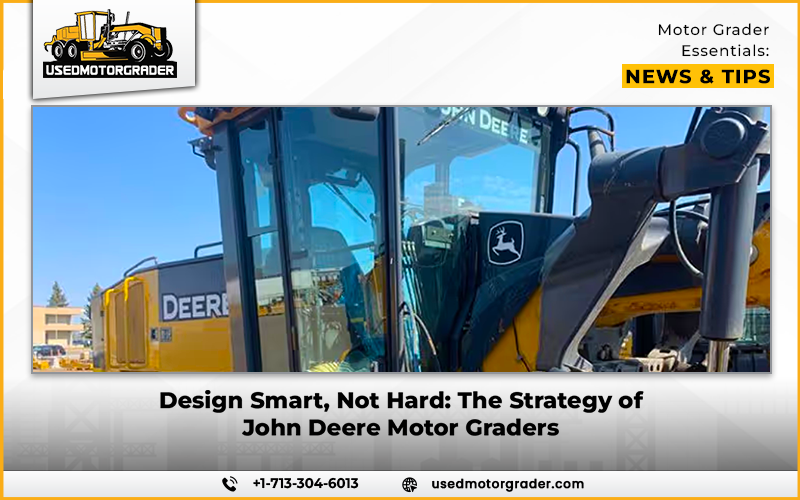Efficiency is all in the world of heavy construction. Contractors seek equipment that is time-saving, cost-saving, and that produces consistent results. John Deere motor graders are different there. John Deere has created machines that focus on operator comfort, high technology, and long-term reliability with a philosophy of design, smart, not hard. What it has created is a motor grader that does not merely move material. It changes the manner in which projects are done.
The Core Design Philosophy of John Deere Motor Graders
John Deere has never focused on equipment that works against the operator. The company does not fill machines with features that are not important, but concentrates on the features that are important.
The main aspects of the Philosophy:
- High-visibility ergonomic cabs.
- Streamlined yet strong control systems.
- Intelligent combination of hydraulics and electronics.
- Focus on fuel efficiency and lower emissions.
This philosophy will see operators spend more time being productive and less time adapting to the machine.
Technology That Defines “Smart” Design
One of the most important aspects of smart design is how it incorporates technology into the machine. John Deere provides its graders with systems that directly enhance performance while being easy to use.
Signature Technologies:
- Grade Pro (GP) control system for accurate blade movements
- SmartGradeTM 3D control system is fully integrated for automated grading
- JDLink telematics for remote machine monitoring and diagnostics
- Joystick steering instead of traditional wheels, less strain
Each of these technologies is a testament to John Deere’s ability to strike a balance between cutting-edge innovation and practical, user-friendly design.
Enhancing Productivity Through Simplicity
In many cases, simplicity means speed. By eliminating the number of levers and switches, John Deere enables operators to work faster and more accurately.
Productivity Gains:
- Intuitive learning curve for new operators
- Less training time than traditional machines
- Reduced onsite errors thanks to automation support
- Optimized blade placement improves grading accuracy
This streamlined approach is not only beneficial for experienced operators but also simplifies the process for companies to train new hires.
Durability and Maintenance Made Simple
Smart design goes beyond the job site. John Deere motor graders are designed for accessibility and long-term use. When machines are designed for convenience, maintenance is less of a burden.
Maintenance Advantages:
- Access to daily service points
- Diagnostics that can spot problems early
- Reduced repair costs because of the modular design
- Extended component life by using advanced engineering
By minimizing downtime, contractors can maximize the value of each machine in their fleet.
Case Studies: Real-World Impact of Smart Design
It’s one thing to discuss innovation. It’s another to see how it works in the real world. Contractors and municipalities are consistently saying that John Deere’s approach is paying off.
Reported Benefits:
- Up to 15% fuel savings on long grading projects
- Less operator fatigue during long shifts
- Higher accuracy in grading urban development projects
- Higher availability with reduced unplanned downtime
These findings underscore the tangible advantages offered by John Deere’s approach in terms of cost savings and performance.
Comparing Smart vs. Traditional Approaches
Traditional graders are still in their place, but they tend to be more demanding of operators and maintenance crews. John Deere’s more intelligent approach eliminates many of these burdens.
Smart vs. Hard Comparison:
- Efficiency: more passes vs. fewer passes
- Comfort: ergonomic tech-driven cabins vs. basic controls
- Maintenance: reactive vs. predictive maintenance
- Operator skill: extensive training vs. intuitive learning
This comparison helps explain why many contractors are opting to replace their older, less intelligent graders with modern, smartly designed graders.
The Future of John Deere Motor Grader Design
John Deere is already looking ahead, making sure that its machines stay at the forefront of innovation. The next generation of graders will take digital integration even further.
Future Outlook:
- Improved fuel systems and hybrid power systems
- Increased remote operation capabilities
- Complete integration with digital project management tools
- AI for Real-Time Project Efficiency Analysis
This vision fits perfectly with the company’s philosophy that has existed for many years: smarter design for smarter construction.
Sum Up
By prioritizing what truly matters, ease of use, advanced technology, and long-term reliability. John Deere motor graders embody the principle of “design smart, not hard.” From their ergonomic cabins to their predictive maintenance tools, each feature has a purpose. This approach not only benefits operators but also provides contractors with predictable returns on their investment.
FAQs
Q1. What makes John Deere motor graders different from competitors?
A: Designed for operator comfort, intuitive controls, and integrated technologies like SmartGradeTM, they are more efficient and user-friendly.
Q2. How does SmartGradeTM technology enhance accuracy?
A: SmartGradeTM fully integrated 3D control automatically adjusts the blade to minimize the number of passes needed and ensure accurate grading.
Q3. Are smart-designed graders more expensive to maintain?
A: Not necessarily. While the technology is sophisticated, diagnostic features and modular components help keep repair costs and downtime low.
Q4. What role will automation play in future John Deere graders?
A: Automation will improve accuracy, ease operator fatigue, and link graders to larger digital project management tools for greater efficiency.


